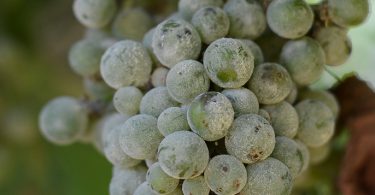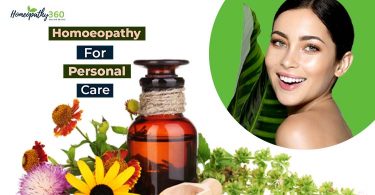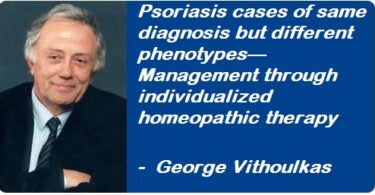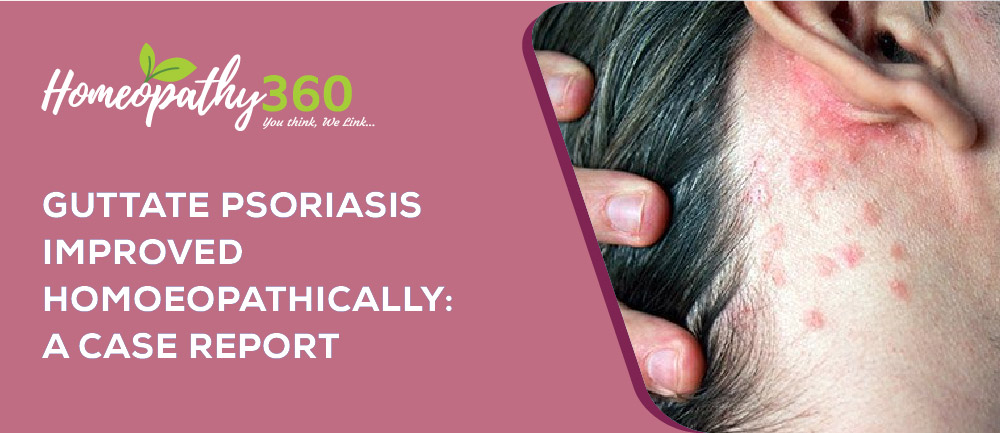
GUTTATE PSORIASIS IMPROVED HOMOEOPATHICALLY: A CASE REPORT
Abstract: Psoriasis is a common, immune-mediated skin disorder that can manifest as multiple clinical phenotypes. Psoriasis affecting most commonly the scalp, face, nails, palms, soles, extremities and intertriginous regions. The plaque psoriasis is the commonly found in the population but there are many types of psoriasis can affect the human population. Among them psoriasis guttate is a form of psoriasis that often starts at an early age (childhood to young adulthood). This is the second most common type of psoriasis, after plaque psoriasis and about 8 percent of people with psoriasis develop guttate psoriasis. Treatment are various and complicated in modern medicine with a low success rate. But in homoeopathy cure can take place by simple means as it is based on the similia similibus curentur. Here a case of guttate psoriasis of three years long improved homoeopathically has been discussed.
Keywords: Guttate psoriasis; homoeopathy; individualisation; Arsenicum iodatum, LM potency
Abbreviation- Arsenicum iodatum (Ars iod), fifty millesimal potency (LM potency), thymus cell (T cell), human leucocyte antigen (HLA), oculus dexter(OD), International classification of diseases (ICD), antistreptolysin O titer (ASO), United States Homoeopathic Pharmacopoeia (HPUS).
Introduction: Psoriasis is a common, immune-mediated skin disorder that can manifest as multiple clinical phenotypes affecting most commonly the scalp, face, nails, palms, soles, extremities and intertriginous regions.1 Guttate psoriasis precipitated by acute streptococcal infection and physical trauma (koebner’s phenomenon) is a major factor in eliciting lesions of psoriasis.2,3Psoriasis can be classified on the basis of onset, evolution and morphology such as chronic plaque psoriasis (commonest), acute guttate psoriasis and pustular psoriasis.4The plaque psoriasis is most commonly found in the population but there are many types of psoriasis can affect the human population. Among them guttate is a variety of psoriasis that often starts at an early age (childhood to young adulthood). This is the second most common type of psoriasis, after plaque psoriasis and about 8 percent of people with psoriasis develop guttate psoriasis.5Guttate psoriasis is a distinctive acute form of psoriasis in which a shower of small erythematous plaques appears in widespread distribution over the body. It develops within 2-4 weeks after an episodic tonsillitis or pharyngitis, mostly due to beta-hemolytic streptococci and up to 33% of the patients can progress to the chronic plaque form in 10 years.6,7,8The diagnosis of psoriasis is primarily clinical and hallmark of classic plaque psoriasis is well-demarcated, symmetric, and erythematous plaques with overlying silvery scale. Removal of scale results in appearance of minute blood droplets (Auspitz’ sign).3 Plaques are typically located on the scalp, trunk, buttocks, and extremities but can occur anywhere on the body. Laboratory findings are not constant when uncomplicated. Increased ASO titre in acute guttate psoriasis with antecedent streptococcal infection is seen.3 The ESR is unaffected, modest hyperuricaemic and occasional low folate level may present.9The guttate psoriasis can be diagnosed by the following features10
The guttate psoriasis has a better prognosis than the other types though it has a tendency to become chronic plaque psoriasis in the later life3. Treatment of psoriasis in conventional treatment is many, like application of topical agents, corticosteroids, and immunosuppressive agents like cyclosporine, acitretin, methotrexate, retinoid analogue tazarotene etc. which have many side effects. 1,7,8 Recurrences and remission are very common in the treatment of psoriasis. In homoeopathy we consider skin diseases as external manifestations of internal disorders. The disease conditions have developed as an expression of the inward turmoil and distress under which the whole individual suffers.11Dr. Samuel Hahnemann says in his Organon of Medicine that the disease is not local although there may be local clinical expression predominantly and he also mentioned that to remove the external malady, internal medicine corresponding to the totality of symptoms should be administered to the patients12. So, when we consider this one should consider administering internal remedy to remove this type of skin disease. One such case, which improved satisfactorily by Homoeopathic treatment, is presented here.
Case history: A male patient named DK aged 9 years came for consultation with skin eruption, exfoliation and crust on legs, abdomen, back. The eruption is too much itchy in nature without any discharge. Silvery White scales were present with raw surface and after scratching scales were coming off. Initially eruption was not spread much but restricted on upper part of the body. He took various local medicines including modern medicine without much benefit. After sometime the patient left the allopathic mode of treatment and switch on to the Homoeopathic mode. Family history – Father- Tuberculosis. Physical generals- Thermal reaction- Hot patient, he can’t tolerate hot weather. His appetite is too much and can’t tolerate hunger; thirst was profuse taking 4-5 lit per day. He had desire for sweets and aversion to brinjal. Tongue was clean and stool was constipated and not satisfactory. Urine was normal. Sleep was disturbed because of fearful dream. Patient had a tendency for catches cold with slight change of weather. Mental general- Irritable, Changeable mood, Fearful, Aversion to answering. Local and systemic examination- on examination it was found that the Auspitz’s Sign is positive. The patient was moderate in built. His vital parameters were all within normal limits.
Diagnosis –The diagnosis of psoriasis is primarily clinical and hallmark of the guttate psoriasis: increased ASO titer in acute condition with streptococcal infection.3The guttate psoriasis can be diagnosed by the following features10 – Acute eruption of “dew-drop,” salmon-pink, fine-scaled, small papules on the trunk or limbs. ICD Code of Guttate Psoriasis is L40.4.13
Analysis – After analysing the case with consideration of mental generals, physical generals and particular symptoms we make the totality of symptom which is the heart of the prescription of Homoeopathic system of medicine. Nature and character of the eruption and itching, thermal reaction of the patients, thirst for large quantity of water, increased appetite, irritability, mood changeability, fear, aversion to answer and tendency to catch cold are the guiding symptoms for prescription.
Evaluation of symptoms
- Mental general- Irritable, changeable mood, aversion to answering.
- Physical generals- Thermal reaction- hot patient, he can’t tolerate hot weather. His appetite is too much and can’t tolerate hunger; thirst was profuse taking 4-5 litres per day. He had desire for sweets and aversion to brinjal. Sleep was disturbed because of fearful dream. Patient had a tendency for catches cold with slight change of weather.
- Particular general – Itching eruption with exfoliation and crust on legs, abdomen, back without any discharge.
Miasmatic interpretation: All skin eruptions are either secondary or tertiary manifestations of miasmatic action. The skin is the mirror or the reflector of the internal stress, the internal dynamics, the internal workings of this human nature14. Master Hahnemann mentioned that 7/8th of all the chronic maladies are from psora while remaining are from syphilis and sycosis or from a complication of two of these three miasmatic chronic diseases or from a complication of all three of them.15 H.A.Roberts mentioned psoriasis as marriage of all the miasms or stigmata, but its characteristics are predominantly psoric and sycotic11.
REPERTORISATION16 – figure: 1

After considering above present totality repertorisation done from software version of Vithoulkas compass indicating following medicines for the case shown in fig- 1. The score from highest to lowest are as follows: Graphites> Iodum > Arsenicum iodatum> Abies canadensis> Kalium sulphuricum> Pulsatilla nigricans> Sulphur etc. After consulting with materia medica finally Arsenicum iodatum in LM potency was given. The selection of LM potency was done as because the case is chronic one and chances of aggravation is more, so to reduce these possibilities, the LM potency is the best as per rule of posology mentioned in Organon of medicine.
Table -2: Follow ups: are presented in a tabular format along with the photograph as follows.
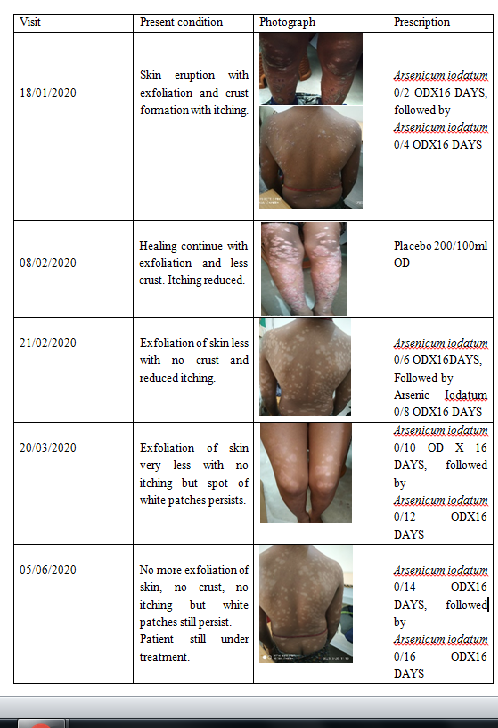
Discussion-
Arsenicum iodatum was originally used by H. Nankivell, on analogical grounds, in cases of phthisis. It has had a short, independent proving and symptoms observed on patients have increased pathogenesis. The conditions resemble more closely those of Arsenicum iodatum than those of Iodum 17. The selection of Arsenicum iodatum is based on the totality of mental general, physical general and particular general of the case. The reason for selection of LM potency is due to chronic condition of the case and the chances of aggravation is least. Further it is easy to modified the doses of LM potency. The patient improved gradually through Arsenicum iodatum in LM potency with proper repetition as per the Hahnemannian guidelines. The assessment of improvement is done by modified Naranjo criteria.
Assessment by modified Naranjo criteria
| SN. | ITEMS | YES | NO | NOT SURE |
| 1. | Was there an improvement in the main symptom or condition for which the homoeopathic medicine was prescribed? | +2 | ||
| 2. | Did the clinical improvement occur within a plausible time frame relative to the drug intake? | +1 | ||
| 3. | Was there an initial aggravation of symptom? | 0 | ||
| 4. | Did the effect encompass more than the main symptom or condition, i.e., were other symptoms ultimately improved or changed? | +1 | ||
| 5. | Did overall wellbeing improve? | +1 | ||
| 6. | Did the course of improvement follow Herring’s Rule? | +1 | ||
| 7. | Did old symptoms (non-seasonal and non-cyclical symptoms that were previously thought to have resolved) reappear temporarily during the course of improvement? | |||
| 8. | Are there alternate causes (other than the medicine) that-with a high probability could have caused the improvement? (e.g. known course of disease, other forms of treatment and other clinically relevant intervention) | +1 | ||
| 9. | Was the effect confirmed by objective evidence as measured by external observation(s)? | +1 | ||
| 10. | Did repeat dosing, if conducted, create similar clinical improvement? | 0 |
The final score in this case was obtained using the modified Naranjo criteria, as proposed by the HPUS clinical data Working Group.18 The total score was 8 and this score suggesting a probable association between the medicine and outcome [definite: ≥ 9; probable 5-8; possible 1-4; and doubtful ≤ 0].
Conclusion:
Homoeopathy is the holistic system of medicine which treats the patient not the disease. In this system of treatment, a constitutional medicine like Arsenicum iodatum which prescribed on the basis of totality of symptom that improve the advance pathological condition like psoriasis. Psoriasis is a psycho-somatic disorder in which disease is developed as because of mental trauma and stress. The fifty millesimal potency is the advanced form of potency which is developed by Hahnemann in 6th edition of organon of medicine after the so many years of work and it is the finest work of entire life of master. In this potency the chances of aggravation and modulation of doses is very much easy so in this case we use the fifty millesimal potency. After the proper homoeopathicity the case was improved satisfactorily and the is still under treatment as the chances of recurrences are always there.
References
- Aldredge, LM.; Higham, RC. Manifestations and Management of Difficult-to-Treat Psoriasis, Journal of the Dermatology Nurses’ Association: 7/8 2018 – Volume 10 – Issue 4 – p 189-197doi: 10.1097/JDN.0000000000000418.
- Karabudak, Ozlem & Dogan, Bilal. (2012). Management of guttate psoriasis in patients with associated streptococcal infection. Psoriasis: Targets and Therapy.2012.89. 10.2147/PTT.S25211.
- Wolff k, Johnson R.A, Suurmond. D. fitzpatrick’s color atlas and synopsis of clinical dermatology; McGraw-Hill medical publishing division; fifth edition;2005; 54-71p
- Mohan H. Text book of pathology; Jaypee brothers’ medical publishers (P) ltd; reprint 2013; sixth edition; 778 p.
- National psoriasis foundation; last updated on 14/01/2020; guttate psoriasis; last access on 7/7/2020(https://www.psoriasis.org/about-psoriasis/types/guttate)
- Karabudak, Ozlem & Dogan, Bilal. (2012). Management of guttate psoriasis in patients with associated streptococcal infection. Psoriasis: Targets and Therapy. 2012. 89. 10.2147/PTT.S25211 ;
- Rendon A, Schäkel K. Psoriasis Pathogenesis and Treatment. Int J Mol Sci. 2019;20(6):1475. Published 2019 Mar 23. doi:10.3390/ijms20061475
- Marks R. roxburgh’s common skin diseases; Arnold publication; 2003; 17th edition 128-142p
- Taurine. R.R.J-Study of folate in psoriasis,blood level, intestinal absorption, British journal of dermatology,1973 335-341p
- Kim WB, Jerome D, Yeung J. Diagnosis and management of psoriasis. Can Fam Physician. 2017;63(4):278-285p
- Roberts. A. H. The Principles and art of cure by Homoeopathy; B Jain Publishers (P) Ltd, Reprint edition 2002. 35-37p, 223p
- Hahnemann S. Organon of medicine; modern homoeopathic publication; 5th &6th edition, Translated by William Boericke, New edition 2006, 103-110p
- ICD.codes; last access on 07/08/2020(https://icd.codes/icd10cm/L404)
- Allen. J.H.- The Chronic miasms, B. Jain Publishers Pvt. ltd, Reprint edition 2004, Pg.257
- Hahnemann S. The Chronic diseases theoretical part; B. Jain Publishers, Reprint edition 2000, 35p
- Vithoulkas Compass ®. v 0.2 0 – beta version. Available online at vithoulkascompass.com (last cited on 3rd June, 2020)
- Clarke JH. A Dictionary of Practical Materia Medica, Vol 1, B Jain Publishers (P) Ltd. 2000. 188p
- The Homoeopathic Pharmacopoeia of the United States. Draft HPCUS Clinical Data Guidelines. Available from: http://www.hpus.com/HPCUS-Clinical-Data-Guidelines-Draft-08-2018.pdf
About Author:
- Dr Dewesh Kumar Dewanshu, MD (Hom- Hom. Pharmacy)
Assistant professor, Dept. of Homoeopathic pharmacy
Govt. Homoeopathic Medical College & Hospital, Paraspani, Godda, Jharkhand
- Dr Bhaskar Sarkar, MD (Hom- Materia Medica)
Assistant Professor, Obs & Gynae
Govt. Homoeopathic Medical College & Hospital, Paraspani, Godda, Jharkhand
- Dr Pralay Sharma, MD (Hom)
Deputy Hospital Superintendent, National Institute of Homoeopathy, Kolkata, WB



